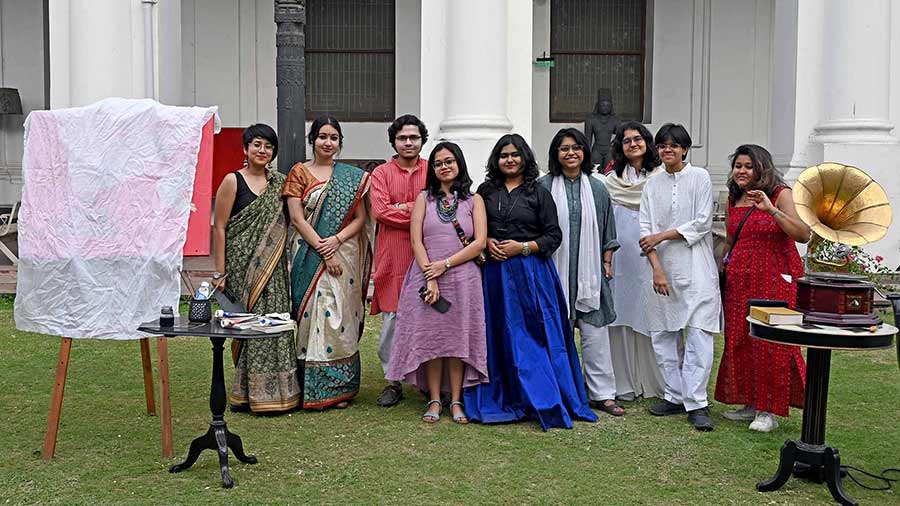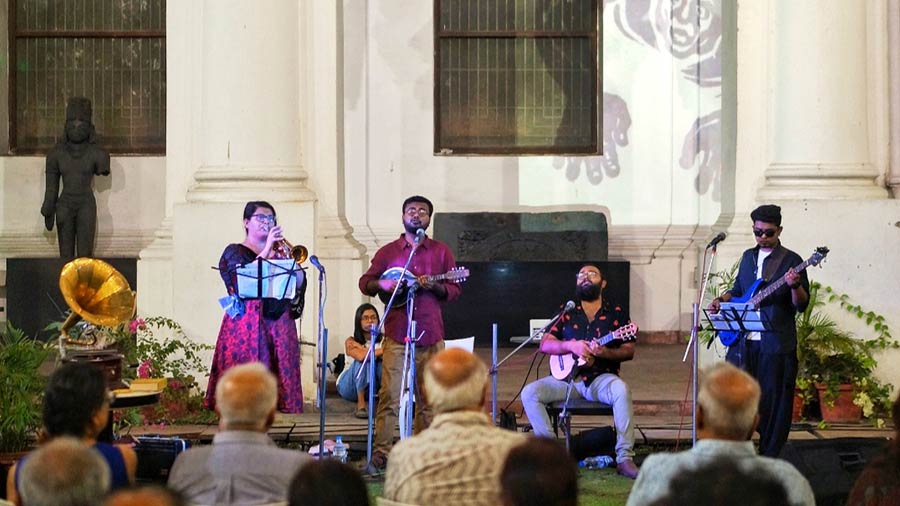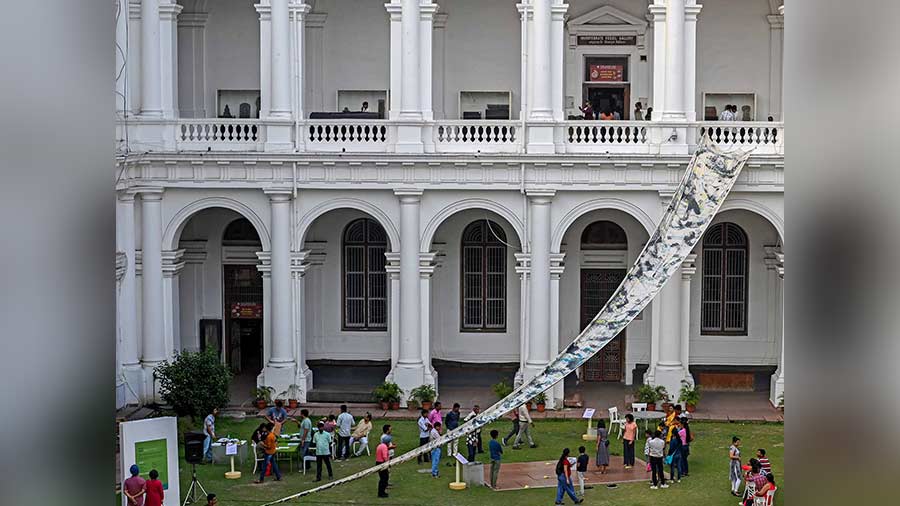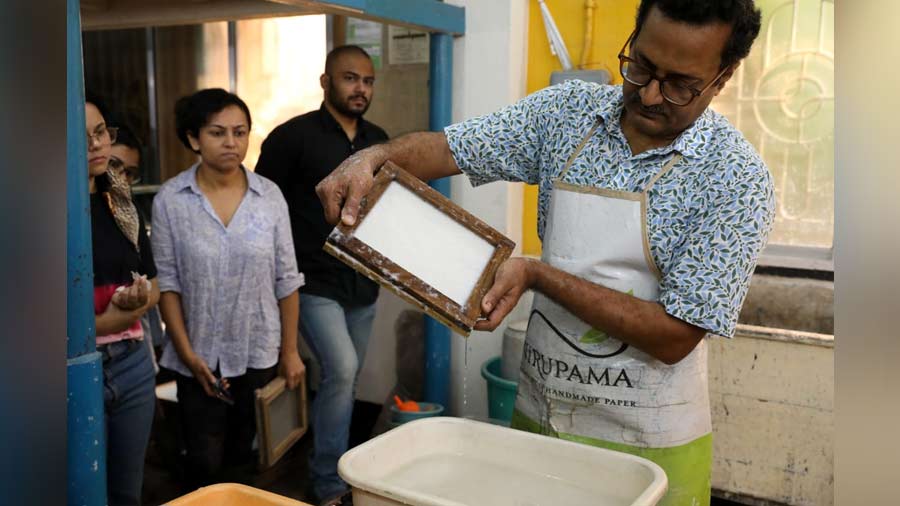The Indian Museum's lawn was abuzz with activities last weekend. Facilitated by DAG Museum, the Playfair was hosted on the grounds. While children were seen trying their hands at making Talpatar Sepai, some were seen tickling their brain cells in trying to find answers to cryptic clues; and to conclude the two-day fair, The Big Other band performed a melodious art-based medley.
Sumona Chakravarty, vice-president, museum DAG commented, “As part of our Museum Programme at DAG, we want to make art accessible to people in different ways. Sometimes it’s through exhibitions but we also think of different ways of engaging people which hook them from the beginning. We thought of taking the idea of playing with artworks and using play as an entry point and convert that into a fair. In the Indian Museum there is such a vast and diverse audience who come every day. So, we thought of something that will appeal to the people of different age groups who visit the museum and thus Playfair came into being. We have been ideating on the games since January but put it all together over the last one month. It has the potential to be a travelling exhibition as well.”
Cryptic Khoj

“Long cuboid structure with specific engravings, a twist or a turn in a throw is the master of your fate.”
Could you guess the answer? Such were the five clues of this game, which participants had to decipher from the decorative gallery and get back to the registration desk with the correct answers. The participants coming back first with the right answers would be given prizes. These objects, which had art all over them, were strewn across the original collections of the Indian Museum. This art hunt piqued the interest of many participants — young and old — who made their way to find the answers to the clue.
P.S: If you didn’t guess the answer, it’s Pansha (the dice game)!
Pin the Prawn

Amit Datta
This classic game required participants to go blindfolded and try to pin the prawn to the cat’s mouth and position the cat’s body marks on it. The artwork of the cat was based on the famous Bengal’s patachitra style while serving as a social metaphor for corruption and stealing.
Lost Travellers

Amit Datta
This unique game was based on the watercolour postcard by Nandalal Bose which allows the participants to view the vast expanse of landscapes and all that it encompasses within. The board game was to be played in duos quite like ludo. The board itself was cut out of the painting by Bose. Each player had to roll a dice and step accordingly while also revealing the faces of the board squares till they found the lost travellers.
Subham Roy came to the museum with his sister Subhasa Roy. He said, “I didn’t know about Playfair but I came here and took part in it. I liked playing Lost Travelers. I recently got a job and will be moving to Gurgaon while my sister just finished her Class XII examinations.” Subhasa added, “This is my first time at the museum and I really love it.”
Talpatar Sepai

Talpatar Sepai is a very famous wooden flip-flop figure in Bengal. Here, one had to make their own figures right from scratch. There were two cut outs — Ravana embracing Hanuman and Mahisasur Mardini. The participant could choose their figures and cut all the parts, attach each of them with thread and needle to both sides of a wooden stick. They could also incorporate speech bubbles to denote a fictional conversation between the characters.
Rudradev Majumder was engaged in making a Talpatar Sepai at the table with a little guidance from the DAG facilitators. He said, “I study in Class VII at National Gems School. I came to visit the museum and loved it. I have never made Talpatar Sepai before. I am making one with an artwork of Hanuman and Ravana and I like it.”
Tactile Tableau

Amit Datta
It is always good to admire finished work of art but does one wonder what goes behind making the art? Taking Gopal Ghose’s gouache pastel painting as a sample, the painting was mounted on several recycled materials which were hidden underneath to give a three-dimensional effect. Participants could walk over the painting and guess what items touched their feet. Some of the recycled items that could be identified were plates, bubble wraps and paper.
Art Shuffle

Amit Datta
Played uno before? This game was all about playing art uno. The cards were based on famous artwork with descriptive keywords comprising artist name, mode of painting, year etc. One had to play in groups or minimum two people to start off the game. All one had to do was match keywords, draw cards and reveal them all one by one.
Gopal Krishna Nandi was immersed in playing a round of uno at the table. He mentioned, “I am a geography student with Calcutta University. I was at the museum and saw Playfair happening and decided to look around. I played Art Uno for the first time and I liked it. Some of the artworks are known like Haren Das, Chittoprasad and some unknown to me.”
Colouring Words

A boost to the audio senses and perceptions, Colouring Words was all about decoding audio clues on artworks and recreating them as per your perception. Art history student Sabyasachi Samanta participated in Colouring Words. He made an artwork based on the audio clues provided. “I study at Rabindra Bharati University. I came to know about the event from Instagram and came over. There was a vivid description about a painting and I tried to recreate it and also add my own touch.” He had reimagined Bijan Chaowdhury’s Untitled oil on ply board painting.
Hatya Khela

There’s been a high society murder and a few well-known icons of the art and literary world are held as suspects. Will the audience be able to find out the killer? This unique amalgamation of art vis-a-vis theatre attracted people from all over as the murder and the interrogation were being staged alive through a theatre. The actors, all university students, made art live and accessible to the visitors. Interestingly, the suspects were based on names of famous artists or characters of the 1930's like Kamini Roy, Chandalal Bose, Maganendranath Tagore, Trinoyani Debi, Bishu Dey and more.
Quiz

“Performed during the annual Chaitra Sankranti over parts of Bengal and Bangladesh, the dance is usually conducted by two people playing the roles of a man and his maternal grandfather, using masks and theatrical storytelling on social issues. Name the art form.”
The Art and entertainment Quiz was an open to all quiz for general participants. One had the opportunity of pre-registering themselves or on-spot registrations were also accepted. The Quiz led by DAG facilitator garnered much interest from people of different age groups who tried their best to wrack their brains and find the answers to the questions.
P.S: Wandering what the answer to the above question is? It's Gombhira.
After Hours Concert by The Big Other

The Big Other, which plays gypsy jazz, put up a finale act for Playfair by incorporating music related to modern art as found in the collections of DAG museum. From Bela Bartok to traditional Sinthi Songs, Moheener Ghoraguli to Tagore, revolutionary music to Albanian folk all held the visitors glued to their seats. Each music piece was inspired by artworks like that of Haren Das, Chittoprasad, and more.


